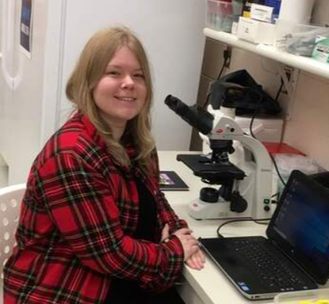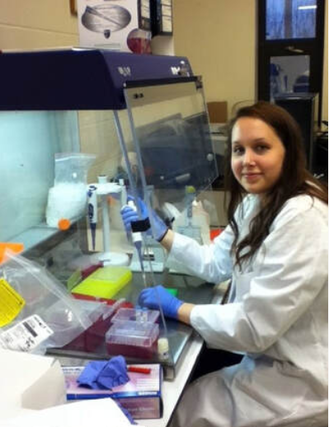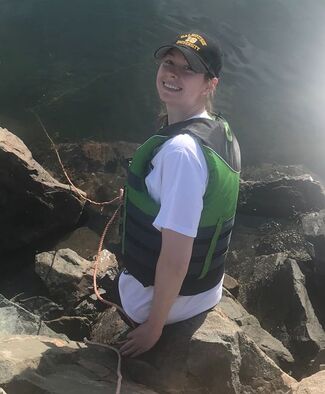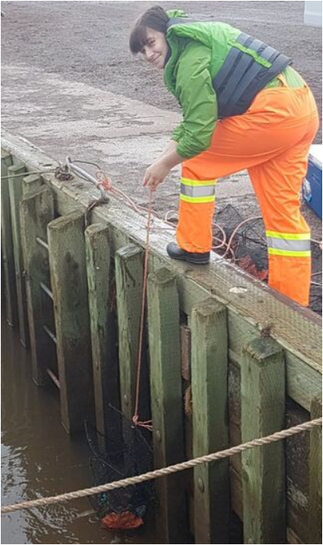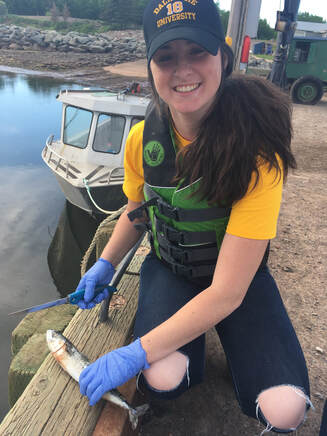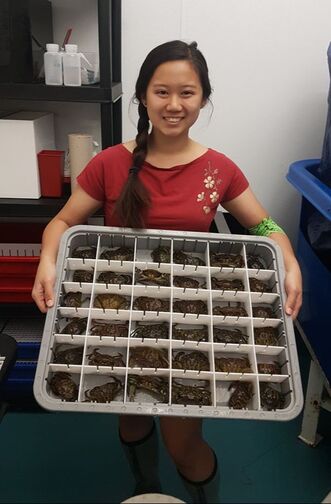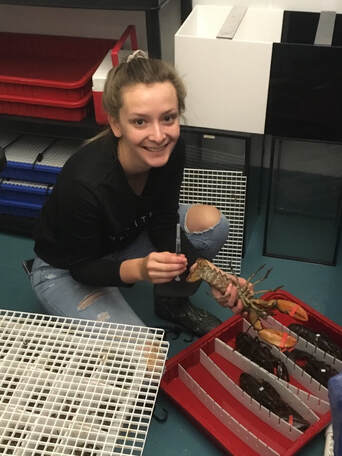|
Hello, I am Sam. I am one of Dr. Clark’s Masters students. After I graduated high school I went to Dalhousie’s Halifax campus and completed a Bachelor of Science (Major in Biology). I then transferred to the Truro campus in 2014 for the Pre-Vet program and decided to stay longer to pursue a Bachelor of Science in Agriculture (Major in Animal Science). My initial intention was to become a veterinarian but I had a change of heart and wanted to gain more research experience. I am currently working on constructing phylogenies based on decapod immune proteins and will be performing behaviour, physiology and parasitology studies on the Atlantic Rock Crab, Cancer irroratus.
Interests: I have always been curious about animals and their way of life, ever since a very young age. If you asked me what my favourite animals are I would probably say cats but reptiles come in at a close second (including birds). I would love to own a bearded dragon someday. I enjoy watching anime, sci-fi, and fantasy shows and movies. My favourite movie is The Dark Knight. |
Sam Stevens
|
I am a PhD student from the Department of Biology at Dalhousie University. My PhD research focuses on the blue mussel (Mytilus edulis) aquaculture industry in PEI, and discovering markers that are related to environmental and mechanical stressors (temperature, salinity, hypoxia, ocean acidification, food availability, tunicate fouling/removal) using the transcriptomic response of mussels, both in a laboratory setting and field. In 2017, I completed my MSc degree from Dalhousie University where my research focused on the Eastern oyster (Crassostrea virginica) aquaculture industry, discovering genetic markers (SNPs) correlated to growth, feed efficiency and stress resiliency using a RAD-seq approach. Ultimately my research interests are focused within the shellfish aquaculture industry, and using a genomic approach to both improve genetic stock through selection in a hatchery setting and also understanding physiological mechanisms involved in stress response and resiliency in the face of climate change.
|
Stephanie Hall
|
I graduated with a BSc in Marine Biology with honours from Dalhousie University, where much of my research was focused on lobster. I am currently a MSc student working several projects including allorecognition in crustaceans and multispectral imaging. My allorecognition research involves primary haemocyte cell cultures from a variety of crustaceans to determine their response to a variety of endogenous and exogenous molecules. I am also examining the possibility of utilizing different wavelengths of light to identify variations in individual crustaceans, such as the present of shell disease or pathogens. This work is combining microelectronic sensors and microcontrollers compatible with Arduino and Raspberry Pi platforms. Finally, I am completing an RNA sequencing project examining the effects of potential prophylactic treatments for viral pathogens of shrimp.
|
Emily Blacklock
|
In 2019, I graduated with a BSc in Bioveterinary Science with honours from Dalhousie University, where my honours project involved quantifying the behavioural effects of environmental enrichment rotation in farmed mink (Neovison vison). I am currently a MSc student focused on determining if infection by the acanthocephalan Profilicollis botulus changes the behaviour of the green crab (Carcinus maenas) in order to make it more vulnerable to one of its predators, the eider duck (Somateria mollissima). I will also be doing a project on comparative crustacean immunology to determine which antimicrobial peptides (AMPs) are present in a variety of crab species native to the coasts of Nova Scotia. The goal of this project is to find out which species have which AMPs and to potentially test these molecules in a laboratory setting to determine which pathogens they are most effective against. My research interests include anything related to animal behaviour and animal welfare.
|
Isabelle Renault
Shannon Kelly
|
I am a fourth year Bioveterinary science Honours student at Dalhousie University. I am examining histocompatability and allorecognition in several crabs present in Atlantic Canadian waters. We are currently completing in vivo experiments and performing biochemical, histopathological and cytological analysis. The goal of my experiment is to determine the extent intra-species histocompatibility.
|
Sin Yee Lee
|
I am a fourth year Bioveterinary Science Honours student at Dalhousie University, Agricultural Campus. My research focus on cellular immunity of Homarus americanus and I am looking at temperature induce alterations in haemocyte culture viability as well as working on establishing a phagocytosis assay. The goal of my project is to determine if temperature will induce changes to H.americanus phagocyte activity.
|
Ève Godin
|
I am a fourth-year biochemistry honours student working to identify virulence factors and complete a phylogenetic analysis on Aerococcus viridans var. homari. This will be done by comparing the genomes of ten different A. viridans strains, five of which are pathogenic and five that are not. Infection of pathogenic A. viridans causes a lethal systemic disease in lobster, which poses an acute threat to the lobster industries. This bacterium can kill a lobster in less than three days and can quickly cause large asset losses to lobsters in live storage. Both the pathogenic and non-pathogenic genomes will be aligned to a reference A. viridans genome (ASM208313v2), this will identify small nucleotide polymorphisms (SNPs), which indicate the possible areas of the genome that conferred virulence to some strains. Following statistical analyses, a shortlist of possible virulence causing SNPs will be annotated and its biological impact determined. This will provide a clear and objective method for identifying pathogenic versus non-pathogenic A. viridans.
|
Emma Garlock
|
I am a fourth year biology honours student researching differences in gene expression between four populations of the Atlantic deep-sea scallop (Placopecten magellanicus) in the Northumberland Strait. My project aims to determine whether the new underwater electricity cable that runs from New Brunswick to Prince Edward Island is having an effect on of the surrounding scallop beds. A total of 76 scallop samples have been taken from four locations across the Northumberland Strait; Cape Tormentine (NB), Pictou (NS), Miminegash (PEI), and West Point (PEI). RNA was extracted and sequenced through Illumina HiSeq4000 PE100 sequencing. I am analyzing these sequences using RNA-Seq bioinformatics as well as using functional annotation to determine differential expression between the four populations. I will be using RT-qPCR to verify my results, and ultimately assess the biological impact that the cable may be having on these scallops.
|
Kristena Daley
|
I am a third year biochemistry student, assisting with research being carried out in the lab. I am examining the effect of temperature on the heart rate of various crab species, using non-invasive photoplethysmography sensors. I am also working to determine the effect of ocean acidification on the gene expression of lobsters, using RT-qPCR. Additionally, I am determining differential gene expression in lobster (Homarus americanus) as a result of infection by acanthocephalan parasites, using bioinformatics tools.
|
Brian Beardsall
|
I am a fourth year biochemistry honours student researching molecular mediators of crustacean acute phase response. The major acute phase protein, serum amyloid A (SAA), is greatly up-regulated in mammals during bacterial infections, and thus it is currently used as a biomarker in human and veterinary medicine. The SAA protein sequence is highly conserved between vertebrate organisms; however, the ubiquity of this protein’s sequence and function among invertebrates, and specifically crustaceans, has yet to be analyzed and remains largely unknown.
My research aims to identify and compare the protein sequence of SAA in transcriptomic datasets from a variety of crustacean species of different habitats. I will be doing a comparative study to determine the feasibility of using a custom lobster polyclonal antibody to quantify SAA in other crustaceans, or provide the necessary information to improve its function. I am also conducting a phylogenetic analysis between these SAA protein sequences to determine if evolutionary history or habitat play a key role in driving evolution of the crustacean innate immune system. This research will expand our knowledge of the crustacean immune system and determine whether SAA expression could be a useful biomarker for crustacean health. Further research to develop SAA diagnostic tests could lead to the prevention of outbreaks resulting in population loss and economic stress in various fishing industries. |
Elizabeth Baker
|
I am a recent graduate from Mount Allison University with a BSc, major in biology and minors in both biochemistry and french. I am currently the laboratory technician and field lead, and I also assist in various research projects. One of these involves testing the physiological tolerance and stress of certain crab species, in response to changes in temperature, using non-invasive photoplethysmography sensors. I am also comparing the differences in gene expression between two life stages of the American lobster (Homarus americanus) after being exposed to various concentrations of a commonly used sea lice pesticide, using bioinformatics tools.
|
Gabrielle Landry
|
I am a fourth-year biology honours student researching toll and immunodeficiency pathway components in crustaceans. Using a comparative immunology approach, I will be focusing on studying various immune molecules in several different crustacean species native to Australia and Canada. A phylogenetic analysis will be performed in order to determine the evolutionary relationship between immune protein sequences in the different species of crustaceans. The aim of this research is to expand our knowledge of the crustacean immune system.
|
Shae Scully
